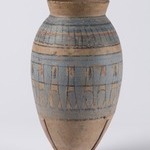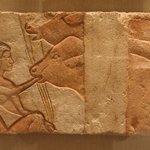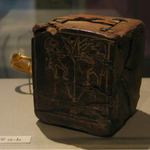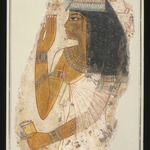
Tomb Painting of a Woman with Offerings
Egyptian, Classical, Ancient Near Eastern Art
This fragment of wall painting from a tomb depicts a woman sitting on a green mat, inhaling the fragrance of a blue lotus. Sealed jars of beer and wine rest under a table loaded with other offerings of white and yellow loaves of bread and a dark red calf’s head. A grid of red lines that guided the draftsman in positioning the objects and proportioning the figures shows through where the paint has worn thin.
MEDIUM
Limestone, gesso, pigment
DATES
ca. 1539–1425 B.C.E.
DYNASTY
early Dynasty 18
PERIOD
New Kingdom
DIMENSIONS
11 1/2 × 12 1/2 × 1 3/8 in. (29.2 × 31.8 × 3.5 cm) (show scale)
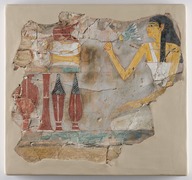


COLLECTIONS
Egyptian, Classical, Ancient Near Eastern Art
ACCESSION NUMBER
05.390
CREDIT LINE
Charles Edwin Wilbour Fund
PROVENANCE
Archaeological provenance not yet documented; before 1905, acquired by an unidentified dealer; 1905, purchased in Egypt from an unidentified dealer by W. M. Flinders Petrie for the Brooklyn Museum.
Provenance FAQ
CATALOGUE DESCRIPTION
Small fragment of a tomb painting with seated woman at right holding a lotus. Before her is a large table of offerings. The painting retains its background of red guide lines. All objects including the figure of the woman are outlined in red. The flesh of the woman is the usual yellow and her dress is white. The pottery is red and the offerings yellow and white. The pavement is a delicate blue, most of which has flaked off.
Condition: The painting has been set into a shallow frame and filled out with plaster painted a deep pink. There are many cracks and small gaps, though the surface is in good condition.
Technique: The gesso is laid on a base of mud and straw (or rushes).
EXHIBITIONS
MUSEUM LOCATION
This item is not on view
CAPTION
Tomb Painting of a Woman with Offerings, ca. 1539–1425 B.C.E. Limestone, gesso, pigment, 11 1/2 × 12 1/2 × 1 3/8 in. (29.2 × 31.8 × 3.5 cm). Brooklyn Museum, Charles Edwin Wilbour Fund, 05.390. Creative Commons-BY (Photo: Brooklyn Museum, 05.390_PS22.jpg)
IMAGE
overall, 05.390_PS22.jpg. Brooklyn Museum photograph, 2024
"CUR" at the beginning of an image file name means that the image was created by a curatorial staff member. These study images may be digital point-and-shoot photographs, when we don\'t yet have high-quality studio photography, or they may be scans of older negatives, slides, or photographic prints, providing historical documentation of the object.
RIGHTS STATEMENT
Creative Commons-BY
You may download and use Brooklyn Museum images of this three-dimensional work in accordance with a Creative Commons license. Fair use, as understood under the United States Copyright Act, may also apply.
Please include caption information from this page and credit the Brooklyn Museum. If you need a high resolution file, please fill out our online application form (charges apply).
For further information about copyright, we recommend resources at the United States Library of Congress, Cornell University, Copyright and Cultural Institutions: Guidelines for U.S. Libraries, Archives, and Museums, and Copyright Watch.
For more information about the Museum's rights project, including how rights types are assigned, please see our blog posts on copyright.
If you have any information regarding this work and rights to it, please contact copyright@brooklynmuseum.org.
RECORD COMPLETENESS
Not every record you will find here is complete. More information is available for some works than for others, and some entries have been updated more recently. Records are frequently reviewed and revised, and we welcome any additional information you might have.














